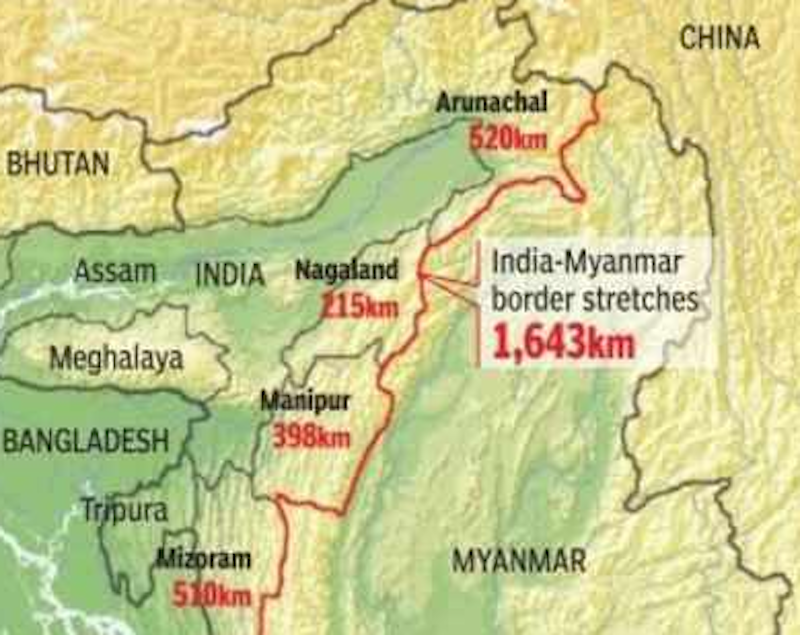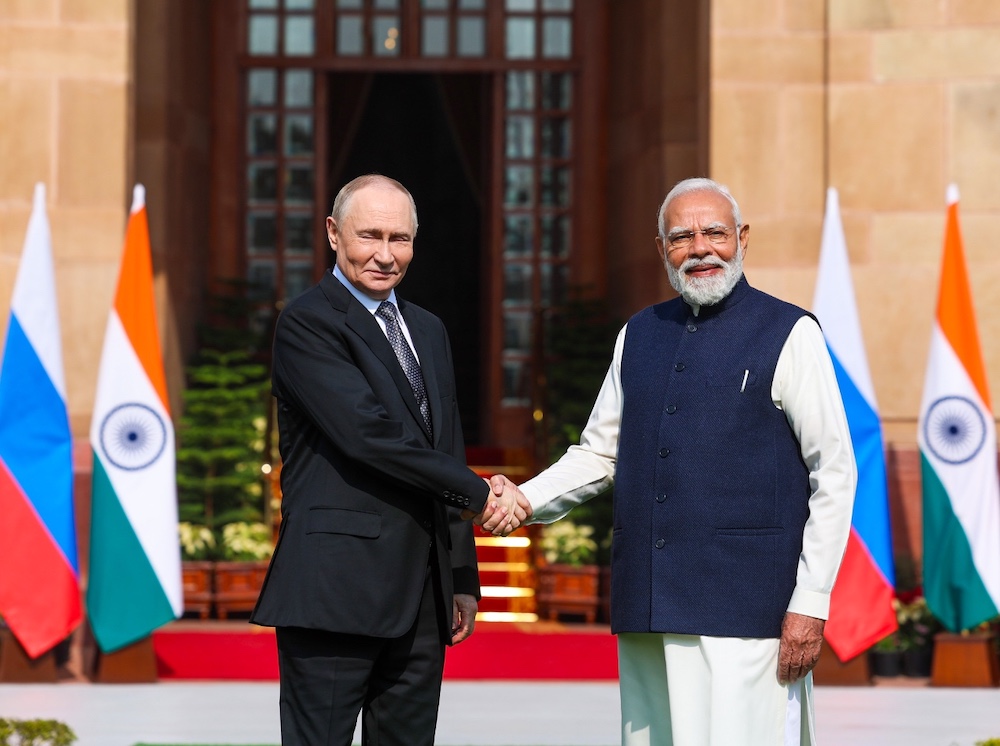 The India-Myanmar border. (Map not to scale.)
The India-Myanmar border. (Map not to scale.)
Kirstjen Nielsen, former secretary of the United States’ homeland security once said: “People think of border security in very different ways, but to me, it’s very simple: border security is national security.” The statement underscores how border security is the key to national security. In the Indian context, the government needs to treat border security and national security as one. Any dilution in border-security imperatives and apparatus endangers national security.
India shares a 1,643-kilometre-long border with Myanmar, which passes through the states of Arunachal Pradesh, Nagaland, Manipur, and Mizoram. The Assam Rifles is tasked to guard this long border. Border guarding means deployment of border-guarding force near the border. Real and practical border guarding entails deployment based upon the border-outpost (BOP) concept. Deployment of these forces far from the border is not border guarding.
Read also: Manipur crisis is becoming national threat, govt must act now
Border guarding entails round the clock and continuous physical domination of the border to plug gaps, prevent infiltration, drugs and arms smuggling, illegal migration, etc. The purpose is to strengthen the security of the border and not allow exploitation of the border belt by anti-national elements. This is only possible when a border-guarding force is physically present on the border.
Hinterland deployment for fighting insurgency cannot be termed border deployment. The present deployment on the India-Myanmar border cannot be termed as “deployment for border security” as it seems more suitable to fight insurgency. It is not possible to do border guarding based upon counterinsurgency deployment. Over a decade ago, there was a proposal to deploy the Border Security Force for guarding the India-Myanmar border for effective border guarding.
Read also: Now, Manipur calls for ‘aggressive’ peace posturing
On November 30, 2010, the Economic Times carried a report that said: “The Border Security Force may soon be tasked with guarding the India-Myanmar border leaving Assam Rifles, the force currently deployed in areas bordering Myanmar to concentrate on counterinsurgency operations in Manipur and Nagaland.” The move was later shelved.
Why was it decided to deploy the BSF on the India-Myanmar border?
In all probability, the Centre felt that the India-Myanmar border needed strengthening for effective border surveillance, which was not possible with counterinsurgency-based deployment. Border guarding was casualty at the altar of such deployment. National security interest also demands that borders are physically under surveillance, and it is only possible when a border-guarding force is physically present on the border. The other reason could be that peacetime responsibility for the border security for international borders falls under the domain of the Union home ministry, whereas operationalization of the Assam Rifles falls under the defence ministry, while the home ministry plays the role of being the administrative ministry of the force.
Read also: Manipur crisis will end only if govt sheds its parochial vision
The duality of command seems to have led to prioritization problems between border guarding, border management and counterinsurgency efforts where border guarding and border management stand diluted on the back burner.
Brigadier Jaspal Singh (retired) faulted the proposed BSF deployment despite visible shortcomings in border security of the India-Myanmar border in his Manekshaw Paper No. 68, 2017, titled “Managing International Borders of India”.
In the paper, he quoted from the January 2014 issue of “Geopolitics”, which reported that on the India-Myanmar border, the BSF would be deployed at the “zero-line” on the international border while the Assam Rifles would be deployed on the rear and conduct counterinsurgency operations only.
Read also: Implement professional protocol for top posts in border-guarding CAPFs
He said such an arrangement, in which two different government agencies are deployed in proximity in the same border region, with the functions of border guarding and counterinsurgency operations divided between them, is highly inadvisable. The functions involving the surveillance of the IB with Myanmar and conduct of counterinsurgency are very much compatible and should be performed by only one single agency in the same border region. Dividing these functions between two different agencies will only lead to friction and conflict from resultant non-productive appropriation of resources. Herein, once again, the concept of “one border, one force” stands violated.
However, Brig Singh’s paper misses the fact that the zero-line border deployment and hinterland counterinsurgency grid are not one but two distinct domains. Treating both as one and compatible amounts to diluting effectiveness of both domains. Both are incompatible and diametrically opposite professional domains. Rather to combine both is inadvisable. Effective border deployment may gradually obviate the need for counterinsurgency forces over a period.
Read also: Pulwama attack needs answers to avoid politicization, end speculations
Considering the porosity of the India-Myanmar border coupled with questions of cross-border infiltration and drugs smuggling, there is a need to revisit the proposal for deployment of the BSF on the India-Myanmar border. The border is on difficult terrain. It has thick jungles and there is a lack of communication network and road connectivity. Security concerns, like cross-border infiltration, drugs and gun trafficking, illegal migration and cross-border support to the narcotics and gun cartels by local people and insurgent groups calls for immediate zero-line deployment on the border. There is also a need to go for infrastructure development all along the border on a war footing.
The BSF, being the first line of defence on the India-Pakistan and India-Bangladesh border, is one of the best professional forces in border security. It has decades of border-guarding experience. It has been guarding similar inaccessible borders in the northeast – Tripura, Assam, and Meghalaya – where many border outposts were air maintained but there was no compromise on quality of border guarding despite inaccessible terrain and connection difficulties. There is an urgent need for strengthening the India-Myanmar border by carrying out forward deployment of troops. There is a need to carry out professional homework on strengthening the border. The expenditure/financial implications should not stand in the way of national security.
Read also: High time govt empowers BSF cadre officers lead force at highest level
Considering the present porosity of the India-Myanmar border and need for zero-line deployment in stages, there is a need to revisit the proposal for deployment of the BSF there. This in no way violates the “one border, one force” concept as the proposed BSF deployment will be for the entire length of the border. The zero-line deployment ensures 24/7 physical domination of the border and will certainly stabilize the border by plugging gaps and preventing cross-border criminal activities, like smuggling, gun-running, infiltration, etc.
The BSF’s deployment will also strengthen our national security in two ways. First, it will ensure effective border domination while the Assam Rifles can be tasked to solely concentrate on counterinsurgency operations. Second, prepare for its conventional role of border defence along with the Indian Army.
Read also: In Punjab, healing touch needed to defang separatists
The government is sensitive to the issues regarding the India-Myanmar border. It knows that strengthening the border is of paramount importance. The quicker it moves forward on this, the better it will serve the interests of our national security.
Disclaimer: The views expressed in the article are the author’s own and don’t necessarily reflect the views of India Sentinels.
Follow us on social media for quick updates, new photos, videos, and more.
Twitter: https://twitter.com/indiasentinels
Facebook: https://facebook.com/indiasentinels
Instagram: https://instagram.com/indiasentinels
YouTube: https://youtube.com/indiasentinels
© India Sentinels 2022-23










